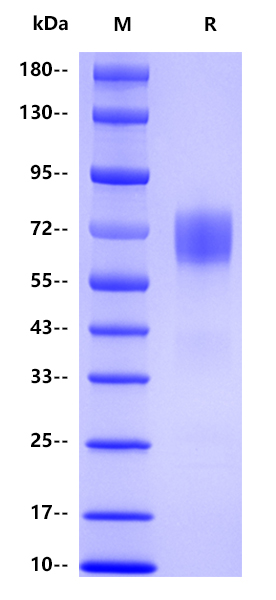Protein sequence(P08697, Asn40-Lys491, with C-10*His)
NQEQVSPLTLLKLGNQEPGGQTALKSPPGVCSRDPTPEQTHRLARAMMAFTADLFSLVAQTSTCPNLILSPLSVALALSHLALGAQNHTLQRLQQVLHAGSGPCLPHLLSRLCQDLGPGAFRLAARMYLQKGFPIKEDFLEQSEQLFGAKPVSLTGKQEDDLANINQWVKEATEGKIQEFLSGLPEDTVLLLLNAIHFQGFWRNKFDPSLTQRDSFHLDEQFTVPVEMMQARTYPLRWFLLEQPEIQVAHFPFKNNMSFVVLVPTHFEWNVSQVLANLSWDTLHPPLVWERPTKVRLPKLYLKHQMDLVATLSQLGLQELFQAPDLRGISEQSLVVSGVQHQSTLELSEVGVEAAAATSIAMSRMSLSSFSVNRPFLFFIFEDTTGLPLFVGSVRNPNPSAPRELKEQQDSPGNKDFLQSLKGFPRGDKLFGPDLKLVPPMEEDYPQFGSPKGGGGSHHHHHHHHHH
>95% by SDS-PAGE
12 months from date of receipt, -20 to -70 °C as supplied. 6 months, -20 to -70 °C under sterile conditions after reconstitution. 1 week, 2 to 8 °C under sterile conditions after reconstitution. Please avoid repeated freeze-thaw cycles.
Alpha 2-antiplasmin (or α2-antiplasmin or plasmin inhibitor) is a serine protease inhibitor (serpin) responsible for inactivating plasmin. Plasmin is an important enzyme that participates in fibrinolysis and degradation of various other proteins. Very few cases (<20) of A2AP deficiency have been described. As plasmin degrades blood clots, impaired inhibition of plasmin leads to a bleeding tendency, which was severe in the cases reported. In liver cirrhosis, there is decreased production of alpha 2-antiplasmin, leading to decreased inactivation of plasmin and an increase in fibrinolysis. This is associated with an increase risk of bleeding in liver disease.

2μg(R: reducing conditions)